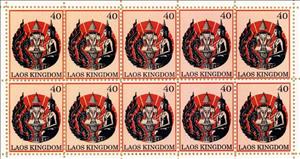Mini Sheet: Symbols of the Nation (Cinderellas 2010)
Symbols of the Nation (Cinderellas 2010)
01 January (Cinderellas ) within release Laos : Kingdom goes into circulation Mini Sheet Symbols of the Nation face value 10*40 No Face Value
| Mini Sheet Symbols of the Nation in catalogues | |
|---|---|
| Colnect codes: | Col: LA-K 2010-02 |
Mini Sheet is square format.
Sheet of cinderella stamps issued by the so-called "Federation of Free States of Asia". Denomination is fictitious, sheets were sold online for GBP 2.20.Also in the issue Laos : Kingdom:
- Mini Sheet - Baby Elephant face value 6*50;
- Stamp - Baby Elephant face value 50;
- Mini Sheet - Chinthe face value 10*60;
- Stamp - Chinthe face value 60;
- Mini Sheet - Coat of Arms face value 10*20;
- Stamp - Coat of Arms face value 20;
- Mini Sheet - Elephant face value 10*25;
- Stamp - Elephant face value 25;
- Mini Sheet - Fruit face value 10*35;
- Stamp - Fruit face value 35;
- Mini Sheet - Golden Buddha face value 10*40;
- Stamp - Golden Buddha face value 40;
- Mini Sheet - Sitting Buddha face value 10*20;
- Stamp - Sitting Buddha face value 20;
- Mini Sheet - Symbols of the Nation face value 10*40;
- Stamp - Symbols of the Nation face value 40;
- Mini Sheet - Temple roof face value 6*40;
- Stamp - Temple roof face value 40;
- Mini Sheet - Wheel face value 10*20;
- Stamp - Wheel face value 20;
|
Data entry completed
50%
|
|
|---|---|
| Mini Sheet Symbols of the Nation in digits | |
| Country: | Cinderellas |
| Date: | 2010-01-01 |
| Emission: | Cinderella |
| Format: | Mini Sheet |
| Face Value: | 10*40 No Face Value |
Mini Sheet Symbols of the Nation it reflects the thematic directions:
Animals are multicellular, eukaryotic organisms of the kingdom Animalia (also called Metazoa). All animals are motile, meaning they can move spontaneously and independently, at some point in their lives. Their body plan eventually becomes fixed as they develop, although some undergo a process of metamorphosis later on in their lives. All animals are heterotrophs: they must ingest other organisms or their products for sustenance.
Buddhism, also known as Buddhadharma and Dharmavinaya, is an Indian religion based on teachings attributed to the Buddha, a wandering teacher who lived in the 6th or 5th century BCE. It is the world's fourth-largest religion, with about 320 million followers, known as Buddhists, who comprise four percent of the global population. It arose in the eastern Gangetic plain as a śramaṇa movement in the 5th century BCE, and gradually spread throughout much of Asia. Buddhism has subsequently played a major role in Asian culture and spirituality, eventually spreading to the West in the 20th century
Elephants are the largest living land animals. Three living species are currently recognised: the African bush elephant (Loxodonta africana), the African forest elephant (L. cyclotis), and the Asian elephant (Elephas maximus). They are the only surviving members of the family Elephantidae and the order Proboscidea; extinct relatives include mammoths and mastodons.
Mammals are any vertebrates within the class Mammalia (/məˈmeɪli.ə/ from Latin mamma "breast"), a clade of endothermic amniotes distinguished from reptiles (including birds) by the possession of a neocortex (a region of the brain), hair, three middle ear bones and mammary glands. All female mammals nurse their young with milk, secreted from the mammary glands. Mammals include the largest animals on the planet, the great whales. The basic body type is a terrestrial quadruped, but some mammals are adapted for life at sea, in the air, in trees, underground or on two legs. The largest group of mammals, the placentals, have a placenta, which enables the feeding of the fetus during gestation. Mammals range in size from the 30–40 mm (1.2–1.6 in) bumblebee bat to the 30-meter (98 ft) blue whale. With the exception of the five species of monotreme (egg-laying mammals), all modern mammals give birth to live young. Most mammals, including the six most species-rich orders, belong to the placental group. The largest orders are the rodents, bats and Soricomorpha (shrews and allies). The next three biggest orders, depending on the biological classification scheme used, are the Primates (apes and monkeys), the Cetartiodactyla (whales and even-toed ungulates), and the Carnivora (cats, dogs, seals, and allies).
A symbol is a mark, sign, or word that indicates, signifies, or is understood as representing an idea, object, or relationship. Symbols allow people to go beyond what is known or seen by creating linkages between otherwise very different concepts and experiences. All communication (and data processing) is achieved through the use of symbols. Symbols take the form of words, sounds, gestures, ideas, or visual images and are used to convey other ideas and beliefs. For example, a red octagon is a common symbol for "STOP"; on maps, blue lines often represent rivers; and a red rose often symbolizes love and compassion. Numerals are symbols for numbers; letters of an alphabet may be symbols for certain phonemes; and personal names are symbols representing individuals.





